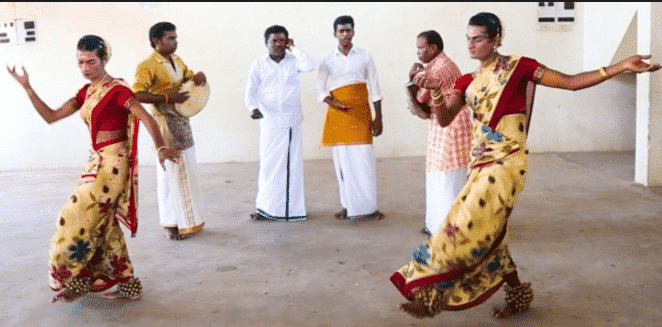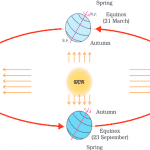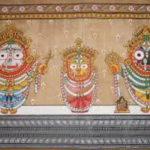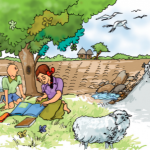Kaniyan Koothu is a folk art with elements of classical music, dance, narration and singing. It is a ritual art form practised during temple festivals in Tamil Nadu.
History
- It is at least 300 years old and can be traced back to the 17th century. There is also a passing reference to the art in Mukkoodarpallu (Tamil poem from the Nayak period).
- But the art form as it is now, similar to a stage performance, is probably 80 years old and is influenced by Tamil drama.
Kaniyans
- Kaniyan koothu gets its name from the community that the artists come from. Kaniyans are a Scheduled Tribe.
- Legend says that they were brought to Earth to sing and dance for Sudalai Madan, the deity of the graveyard (an incarnation of Lord Shiva).
- The performers receive no formal training. They pick up the songs and the stories by listening to their fathers.
- Their population is less than 750 and only around 200 persons are currently performing the art.
Themes
- It tells Puranic stories such as Markandeya Puranam and Harishchandra Puranam and tales from the Ramayana and the Mahabharatha.
- The stories are narrated in Tamil.
- The Koothu usually goes on for two nights and a day.
- Stories and their narration are central to this art form.
- It is performed to invoke the spirit of Sudalai during Kodai-an annual celebration.
Performers
- It is performed only by men.
- It is performed by a team of six members.
- This includes a lead singer, an assistant singer, two drummers, and two dancers.
- The annavi or the main singer is usually supported by a second singer.
- Two artists play the magudam- one plays the bass and the other the sharper version. Playing the magudam is different from the thappu, which it resembles, in that the magudam is played by striking it with the hand. The magudam is expensive to make and maintain.
- As they play the instruments at breakneck speeds, in perfect sync, the effect is terrific.
- Two men, dressed as women, dance to the tune with immense energy. The dancing demands a lot of stamina and creativity.
A Dying Art
- It has a disadvantage as it cannot be practised part-time. And it is not remunerative enough to pursue as a full-time job.
- The art today is facing a crisis, not because of lack of patronage, but because not many come forward to take it up as a profession.
- Sanskritisation of worship is another obstacle for this art form.
- Kaniyan Koothu is a ritual art form.But it is no longer central to the way of worship as it once was because the deities and temples are rapidly getting Sanskritised.
- Brahmin priests in the sanctum sanctorum, Sanskrit prayers and vegetarian offerings are encouraged over the forms of worship and sacrifices that existed previously. As a result, Kaniyan Koothu and other ritual art forms will get affected because they have no place in a Sanskritised form of worship.
Solutions for Revival
- One way to keep the art going is to recognise practitioners with awards and make the form accessible and inclusive.
- Kaniyan Koothu can be taught at government-run music schools to people from other communities too.
कानियाँ कूथु
- कानियाँ कूथु एक लोक कला है जिसमे शास्त्रीय संगीत, नृत्य, कथा एवम संगीत के तत्व पाए जाते है| यह एक शास्त्रीय विधि की कला है जो तमिलनाडु के मंदिर पर्व के समय आयोजित किये जाते है|
इतिहास
- यह एक ३०० वर्ष पुरानी कला है| मुक्कूदार्पल्लू (नायक काल की तमिल कविता) में इस कला के सन्दर्भ में कुछ चीजे मिलती है|
- वर्तमान काल में इस कला का प्रारूप मंच प्रदर्शन शायद ८० वर्ष पुराना है और यह तमिल नाटक से मिलता जुलता है |
कानियाँ
- कानियाँ कूथु का नाम उसके कलाकारों के समुदाय के नाम से पड़ा , कानियाँ एक अनुसूचित जनजाति है
- किवंदतियो के अनुसार उन्होंने धरती पर ‘सुदलाई मदन” के लिए गाने और नृत्य करने के लिए जन्म लिया है जिन्हें शमशान का देवता (भगवान् शिव के अंश) कहा जाता है |
- इस जनजाति की जनसँख्या ७५० से भी कम है और इनमे से केवल २०० लोग ही इस कला का प्रदर्शन कर रहे है |
विषय
- ये मार्कंडेय पुराणं तथा हरिश्चन्द्र पुराणं से पौराणिक कथाये तथा रामायण, महाभारत की कहानियों को बताते है |जिनका तमिल भाषा में वर्णन करते है|
- सामान्य रूप से कूथु २ रात्री तथा १ दिन तक चलता रहता है|
- कहानिया एवम कथन इस कला में केन्द्रित होतेहै |
- कोदई नामक वार्षिक उत्सव पर सुदालाई के आत्मा के आह्वान के लिए इस कला का प्रदर्शन किया जाता है |
अदाकार (अभिनेता)
- इसका प्रदर्शन केवल पुरुष करते है |
- यह ६ सदस्यों के समूह के द्वारा प्रदर्शित किया जाता है|
- जिसमे एक मुख्य गायक,एक सहायक गायक,दो ढोलवादक तथा दो नर्तक होते है |
- सामन्यता अन्नावी (मुख्य गायक) एक द्वितीय गायक की सहायता लेता है|
- दो कलाकार मगुदम बजाते है जिसमे एक धमक तथा दूसरा छमक के धुन में बजाते है |
- थाप्पू की तरह दिखने वाले मगुदम को अपेक्षाकृत अन्य तरीके से जैसे -हाथो से थोक कर बजाया जाता है , मगुदम का रखरखाव तथा निर्माण अत्यधिक खर्चीला होता है |
- जब वे वाद्य यंत्रो को भयंकर रफ़्तार तथा उत्तम ताल से मिलाकर बजाते है तो उसका प्रभाव दिल को दहलाने वाला होता है |
- महिलाओ के वस्त्र में दो पुरुष धुन पर अत्यधिक शक्ति से नृत्य करते है, इस नृत्य में अत्यधिक स्फूर्ति एवम कलात्मकता की जरुरत होती है|
एक मृतप्राय कला
- इसका एक नुकसान ये है की इसे अंशकालिक प्रदर्शित नहीं कर सकते है तथा यह उतना लाभप्रद भी नहीं है कि इसका पूर्णकालिक प्रदर्शन किया जाये |
- यह कला आजकल समस्याग्रस्त है जिसका कारण सिर्फ संरक्षण की कमी ही नहीं बल्कि इसको एक व्यवसाय के रूप में आगे बढाने वालो की कमी भी है |
- पूजा विधियों का संस्कृतिकरण हो जाना भी इसके लिए एक बाधा है|
- कनियाँ कूथु एक शास्त्रीय कला है लेकिन पूजा के रूप में यह ज्यादा केन्द्रित नहीं हो पाई जिसका कारण है की सारे मंदिर एवम देवता का तीव्रता से संस्कृतीकरण हो रहा है|
- पवित्र स्थानों एवम मंदिरों में ब्राह्मणों तथा शाकाहारियो के संस्कृत में उपासना, प्रार्थना से पूजा के प्रारूप में बदलाव आये जिनसे इस तरह के प्रारूपो का मनोबल गिर गया, कनियाँ कूथु तथा अन्य शाश्त्रीय कला पर भी इसका प्रभाव पड़ेगा क्योकि संस्कृतिकरण के पूजाविधि में इनका कोई भी स्थान नहीं है |
पुनरुथान के उपाय
- एक रास्ता यह भी है की पुरस्कारों से इसके कलाकारों को मान्यता दी जाये तथा इसके विधियों को सुलभ तथा समावेशी बनाया जाये |
- कनियाँ कूथु को सरकार द्वारा चलाये जा रहे संगीत विद्यालयों में अन्य समुदायों के लोगो को भी सिखाया जाये|











